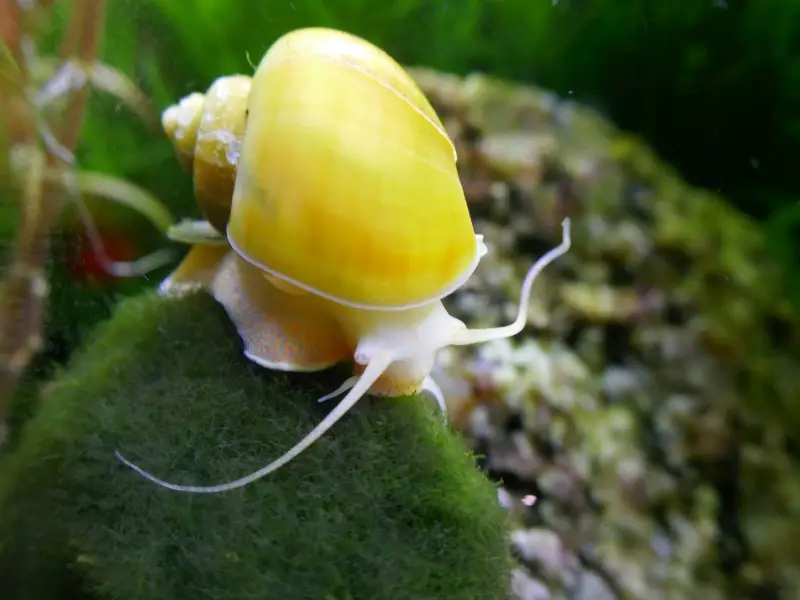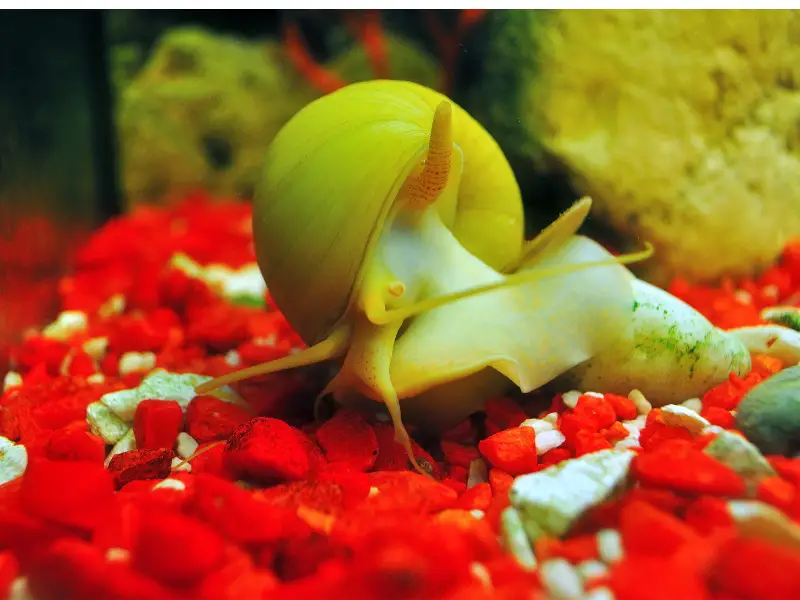If you’re looking for an interesting and unique addition to your aquarium, the gold Inca snail might just be the perfect fit.
These snails are known for their stunning golden shells and playful personalities, making them a popular choice among aquarium enthusiasts.
But there’s more to these snails than just their good looks. Gold Inca snails are great at keeping your tank clean by eating algae and other debris. They are also peaceful creatures, making them a great addition to community tanks.
And if you’re worried about their care, don’t be. Gold Inca snails are easy to care for and can thrive in a variety of tank setups.
So if you’re looking for a low-maintenance, visually appealing, and helpful addition to your aquarium, the gold Inca snail might just be the perfect fit for you.
Gold Inca Snail Overview
Here’s a table for a quick overview of gold Inca snail facts:
| Scientific Name: | Pomacea bridgesii |
| Common Names: | Gold Inca snail, gold mystery snail, mystery apple snail |
| Size: | 2-3 inches in diameter |
| Lifespan: | 1-2 years |
| Color: | Golden or yellowish-brown shell with a dark spiral pattern |
| Temperament: | Peaceful and non-aggressive |
| Care Level: | Easy |
| Minimum Tank Size: | 10 gallons |
| Diet: | Herbivore |
| Compatibility: | Peaceful community fish, but may eat live plants |
Appearance and Size
Gold Inca snails, also known as gold mystery snails or mystery apple snails, are a stunning addition to your aquarium.
They have a deep yellow and gold shell, with a creamy white body, head, and foot.
Orange dots are often sprinkled around their mouth area, making them even more visually appealing.
These snails reach an average size of 2 inches (5 cm) in diameter and 3 inches (8 cm) in length.
Lifespan
Depending on the quality of care you provide, your gold Inca snail can live for about 1-2 years.
This means that by maintaining proper water quality and feeding your snail regularly, you can enjoy their presence in your aquarium for quite some time.
Behavior
Gold Inca snails are known for their peaceful behavior; they get along well with most tank mates.
As herbivores, they naturally consume algae and organic detritus, helping to keep your aquarium clean.
They’re also nocturnal, so you’ll often notice them being more active during the evening and night hours.
Gold Inca Snail Habitat and Tank Conditions

Gold Inca snails originate from swamps, rivers, and slow-moving ponds with dense vegetation and low-light conditions.
In this section, we’ll discuss how to recreate their natural environment in your aquarium.
Tank Size
Start by choosing the right tank size for your gold Inca snails.
They require a minimum of 10 gallons to thrive, but larger tanks are always better.
A bigger tank offers stable water conditions, more space for growth and activity, and can accommodate more compatible tank mates.
Water Conditions
Gold Inca snails are adaptable, but it’s essential to maintain proper water conditions to keep them healthy.
Maintain a water temperature between 68-82°F, a pH level of 7.0-8.0, and a water hardness of around 12-18 dGH.
Regular water testing is crucial to detect any significant changes in water parameters, allowing you to make adjustments swiftly.
Aquarium Setup
A well-planned aquarium setup is essential for replicating the gold Inca snail’s natural habitat.
Here’s how to create a comfortable space for them:
1. Substrate and Decorations
Use soft sand, like this one, or fine gravel substrate to avoid damaging their delicate shell and antennae.
Incorporate plenty of hiding places using driftwood, caves, and PVC pipes.
Adding live plants, like Java fern and Anubias, will not only offer shelter but also replicate the gold Inca snail’s natural, densely vegetated environment.
2. Lighting and Filtration
Gold Inca snails prefer low-light conditions, so avoid intense lighting that may stress them.
Provide a balance of light and shade using floating plants such as frogbit.
A gentle filtration system, like this one from Amazon, is necessary to keep the water clean without creating strong currents that might disrupt their slow-paced lifestyle.
Gold Inca Snail Diet
In their natural habitat, gold Inca snails feed mainly on algae and other vegetation.
In your aquarium, they’ll continue their algal feast, helping keep your tank clean in the process.
To supplement their in-tank diet, you can provide them with algae wafers, like these ones, fresh vegetables, and calcium supplements to ensure healthy shell growth.
Remember to always remove any uneaten food to maintain optimal water conditions.
Your snails will appreciate the live plants in your tank setup but fear not, they generally won’t eat them.
They would rather graze on the substrate and decorations in search of algae.
Compatibility and Tank Mates
Choosing the right tank mates for your gold Inca snail is essential to ensure a peaceful and harmonious environment.
These snails are non-aggressive by nature and can thrive with a variety of tank mates.
Ideal tank mates for gold Inca snails are:
- Tetras
- Killifish
- Guppies
- Amano shrimp
- Ghost shrimp
- Cherry shrimp
- Ramshorn snails
Be cautious with larger or more aggressive fish species, as they may harm your snail.
It’s essential to keep in mind that while the gold Inca snail is peaceful, it still needs protection from potential predators.
Avoid tank mates with a reputation for snail-eating, such as pufferfish or some cichlids, which can cause harm to your gold Inca snail.
Gold Inca Snail Breeding

Breeding gold Inca snails is pretty straightforward! First, you’ll need both male and female snails in your tank for successful fertilization.
Determining their gender can be tricky, so start with a group of around 5 snails to increase your chances of having both.
Now, let’s set the mood for your snails. Ensure the tank temperature is around 68-82°F (20-28°C) and the pH level should be between 7.0-7.5.
This will create a stable environment for them to feel cozy and encourage breeding.
Keep an eye on your snails, and when you spot the female laying eggs, it’s showtime!
Don’t worry about the eggs—they’ll be fine. Just let nature take its course, and in about two weeks, you’ll have tiny new gold Inca snails to marvel at.
Remember, be patient and enjoy the process, your little snail family is growing!
FAQs About Gold Inca Snail
Are Gold Inca Snails Good?
Yes, gold Inca snails are often considered a beneficial addition to your aquarium.
They help keep your tank clean by grazing on algae that grow on the glass and decorations.
As a bonus, their distinct color and appearance make them attractive inhabitants in your tank.
However, it’s important to note that they may eat live plants, so it’s important to choose tankmates accordingly.
Are Gold Inca Snails Asexual?
Gold Inca snails are not asexual. They have separate sexes, with males and females needing to mate to reproduce.
Males can be distinguished from females by their genital openings, which are located on different parts of their bodies.
It’s important to note that gold Inca snails can breed quickly and produce a lot of offspring, so it’s important to keep their population in check to prevent overcrowding in the tank.
Can Gold Inca Snails Breathe Air?
Yes, gold Inca snails have a lung-like organ called a “pallial lung” that allows them to breathe air.
This adaptation enables them to survive in low-oxygen environments and also allows them to come to the water’s surface to breathe.
However, they still require water to survive, and their gills are their primary means of extracting oxygen from the water.
It’s important to provide adequate aeration and water quality in their tank to ensure they have access to enough oxygen to breathe.
Additionally, it’s important to ensure that the water level in their tank is not too high, as they need to be able to reach the surface to breathe air.
Is a Gold Inca Snail a Mystery Snail?
A gold Inca snail is a type of Mystery snail and it is one of several species of mystery snails.
Mystery snails are known for their unique appearance, peaceful temperament, and ability to help keep aquariums clean by eating algae and other debris.
Related Articles:
